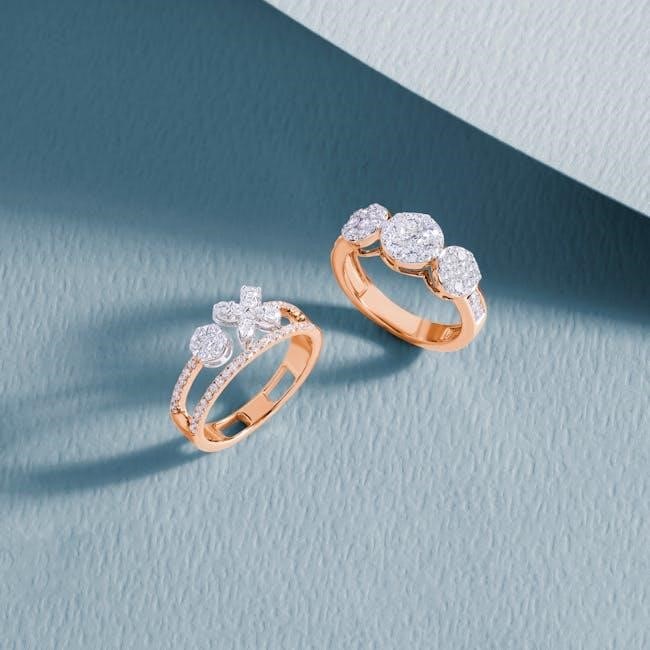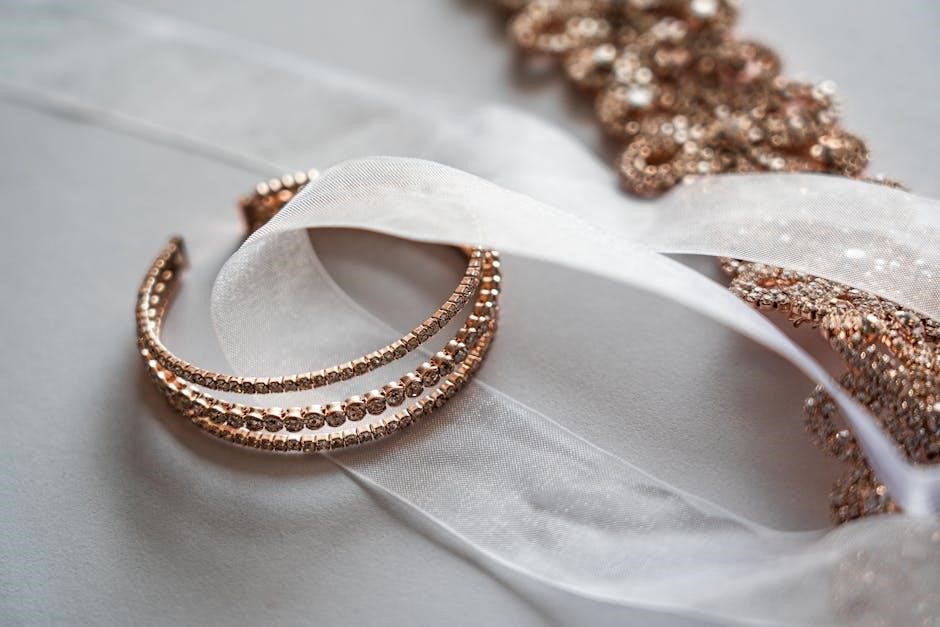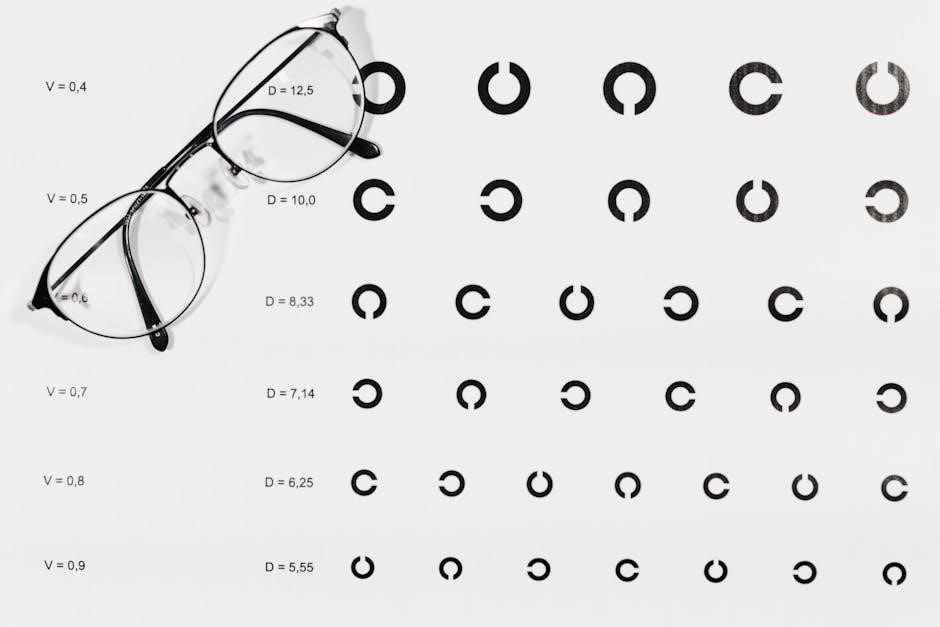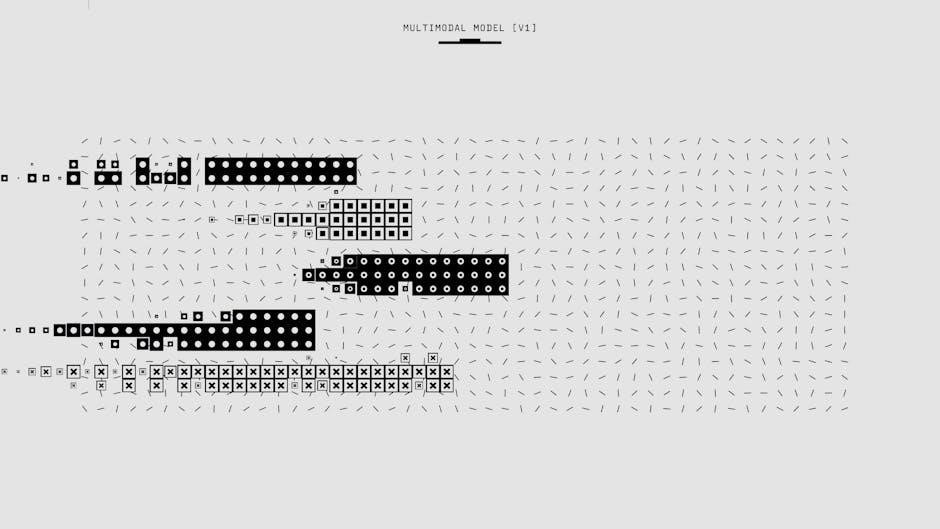Discover the fundamentals of the 4 Cs of diamonds—carat‚ color‚ clarity‚ and cut․ This essential guide provides a clear understanding of each factor‚ helping you make informed decisions when selecting the perfect diamond․ Use a 4 Cs chart PDF to compare and evaluate diamonds effectively‚ ensuring your choice meets your preferences and budget․

Overview of the 4 Cs
The 4 Cs—Carat‚ Color‚ Clarity‚ and Cut—are the cornerstone of diamond evaluation․ Each factor plays a unique role in determining a diamond’s quality and value․ Carat refers to weight‚ Color to whiteness‚ Clarity to inclusions‚ and Cut to craftsmanship․ Understanding these elements helps buyers make informed decisions․ A 4 Cs chart PDF provides a visual guide‚ simplifying comparisons and ensuring alignment with personal preferences․ Whether prioritizing size‚ brilliance‚ or purity‚ the 4 Cs framework offers clarity and confidence in selecting the ideal diamond․ Robbins Brothers and deBebians emphasize their importance‚ making the chart an indispensable tool for buyers․
Importance of Understanding the 4 Cs
Understanding the 4 Cs is crucial for evaluating diamonds accurately․ Each factor—Carat‚ Color‚ Clarity‚ and Cut—directly impacts a diamond’s value and appearance․ Knowledge of these criteria helps buyers avoid overpaying and ensures they purchase a diamond that meets their standards․ A 4 Cs chart PDF serves as a practical tool for comparing diamonds side by side․ Whether focusing on size‚ brilliance‚ or purity‚ grasping the 4 Cs empowers buyers to make informed decisions․ This expertise not only enhances the purchasing experience but also guarantees satisfaction with the final choice․ Robbins Brothers and deBebians highlight the significance of these standards for a confident purchase․
How the 4 Cs Affect Diamond Value
The 4 Cs significantly influence a diamond’s value‚ with each factor contributing uniquely to its overall worth․ Carat impacts price directly‚ as larger diamonds are rarer․ Color affects value through its grading scale‚ where colorless diamonds are more valuable․ Clarity‚ determined by inclusions and blemishes‚ influences brilliance and desirability․ Cut‚ while subjective‚ greatly impacts a diamond’s brilliance and fire‚ with well-cut diamonds commanding higher prices․ A 4 Cs chart PDF helps visualize these relationships‚ enabling buyers to assess how each attribute contributes to a diamond’s value․ This comprehensive understanding ensures informed decisions‚ balancing personal preferences with budget constraints for a wise investment in a diamond․

Carat: Understanding Diamond Weight
Carat measures a diamond’s weight‚ not size․ Larger carat diamonds are rare‚ making them more valuable․ Use a 4 Cs chart PDF to compare carat weights effectively․
Definition of Carat and Its Significance
Carat is the unit of weight used to measure diamonds‚ with 1 carat equal to 0․2 grams․ It is a critical factor in determining a diamond’s value‚ as larger carat diamonds are rarer and more desirable․ Understanding carat weight helps buyers assess size and price․ A 4 Cs chart PDF provides a detailed comparison of carat weights‚ making it easier to evaluate diamonds․ While carat reflects weight‚ not size‚ it significantly impacts perceived value․ Robbins Brothers and deBebians emphasize the importance of carat in their guides‚ helping consumers make informed decisions․ Use a carat chart to balance size‚ budget‚ and quality effectively․
How Carat Weight Impacts Diamond Price
Carat weight significantly influences a diamond’s price‚ as larger diamonds are rarer and more sought after․ The price per carat increases exponentially with size‚ making higher-carat diamonds more valuable․ For example‚ a 2-carat diamond is not only double the weight of a 1-carat diamond but also substantially more expensive due to its scarcity․ Market demand‚ cut quality‚ and certification also play roles‚ but carat remains a primary driver of cost․ A 4 Cs chart PDF helps buyers visualize how carat weight compares across diamonds‚ aiding in balancing size‚ budget‚ and quality․ Understanding this relationship is key to making an informed purchase decision․
Carat Weight vs․ Diamond Size
Carat weight measures a diamond’s mass‚ while size refers to its dimensions․ A higher carat weight generally correlates with a larger appearance‚ but size can vary based on cut and shape․ For instance‚ a well-cut diamond may appear larger than a poorly cut one of the same carat weight․ Understanding this distinction helps in evaluating diamonds accurately․ A 4 Cs chart PDF provides a visual comparison‚ allowing buyers to assess how carat weight translates to size․ This tool aids in balancing preferences for size‚ quality‚ and budget‚ ensuring a diamond’s dimensions align with its weight and desired aesthetic appeal effectively․

Color: The Grading Scale of Diamonds
Diamond color is graded from colorless (D) to light yellow or brown (Z)․ A 4 Cs chart PDF helps visualize this scale‚ guiding buyers in selecting diamonds with desired hue․
Understanding the Diamond Color Grading Scale
The diamond color grading scale ranges from D (colorless) to Z (light yellow or brown)․ A 4 Cs chart PDF provides a visual guide to these grades‚ helping buyers compare diamonds․ Each grade represents subtle differences in color‚ with D-F being colorless‚ G-J near colorless‚ and K-M having faint hints of color․ Lower grades (N-R) show very light color‚ while S-Z exhibit noticeable tint․ Understanding this scale helps buyers evaluate a diamond’s quality and value․ The chart simplifies the process‚ making it easier to identify the best diamond for your budget and preferences․ Color significantly impacts brilliance‚ so choosing the right grade is essential for achieving desired fire and sparkle․
How Color Affects a Diamond’s Appearance
Diamond color significantly impacts its overall appearance․ Colorless diamonds (grades D-F) maximize brilliance and fire‚ as they refract light without tint․ As color increases (grades G-Z)‚ a diamond may appear less radiant‚ with a yellow or brown tint becoming more noticeable․ The 4 Cs chart PDF illustrates these differences‚ helping buyers visualize how color grades affect a diamond’s aesthetic appeal․ While color preferences are subjective‚ understanding this aspect ensures the chosen diamond aligns with desired visual properties․ Higher color grades are generally preferred for their purity‚ but lower grades can offer excellent value while still appearing beautiful‚ especially when set in jewelry that complements their characteristics․
Color Grading: Certified vs․ Non-Certified Diamonds
Understanding the difference between certified and non-certified diamonds is crucial for accurate color grading․ Certified diamonds are evaluated by reputable laboratories‚ such as the Gemological Institute of America (GIA)‚ and receive detailed reports․ Non-certified diamonds lack this documentation‚ making their grading less reliable․ A 4 Cs chart PDF provides a standardized scale to compare color grades‚ ensuring consistency․ Certified diamonds often command higher value due to their verified quality‚ while non-certified options may offer cost savings but with greater uncertainty․ Using a chart helps buyers evaluate both types‚ making informed decisions aligned with their budget and preferences for diamond appearance and authenticity․

Clarity: Inclusions and Blemishes
Clarity refers to the presence of inclusions (internal) and blemishes (external) in diamonds․ A 4 Cs chart PDF helps identify clarity grades‚ impacting a diamond’s transparency‚ brilliance‚ and value․
What Are Inclusions and Blemishes?
Inclusions are internal imperfections within a diamond‚ such as feathers‚ clouds‚ or black dots‚ while blemishes are external markings like scratches or pits․ These natural imperfections occur during diamond formation or cutting․ Inclusions can affect transparency and brilliance‚ while blemishes may impact durability․ The 4 Cs chart PDF provides a detailed guide to identify and classify these imperfections‚ helping consumers understand how they impact clarity grading․ Inclusions and blemishes are unique to each diamond‚ acting as natural fingerprints․ They are graded based on their size‚ location‚ and visibility under magnification‚ with fewer imperfections generally increasing a diamond’s value․
Clarity Grading Scale and Its Importance
The clarity grading scale‚ developed by the Gemological Institute of America (GIA)‚ categorizes diamonds based on the presence of inclusions and blemishes․ Ranging from Flawless (FL) to Included (I)‚ the scale determines how imperfections affect a diamond’s transparency and brilliance․ Higher clarity grades indicate fewer imperfections‚ enhancing the diamond’s value and light performance․ The 4 Cs chart PDF provides a detailed breakdown of each clarity grade‚ helping buyers understand how inclusions and blemishes impact appearance․ Clarity is a critical factor in determining a diamond’s quality and price‚ making it essential to review the grading scale before making a purchase․
How Clarity Affects Diamond Brilliance
Clarity significantly impacts a diamond’s brilliance by influencing how light interacts with the stone․ Diamonds with fewer inclusions and blemishes allow more light to pass through‚ resulting in greater brilliance and fire; Inclusions can block or scatter light‚ reducing the diamond’s sparkle․ The GIA clarity scale grades diamonds from Flawless to Included‚ with higher grades indicating fewer imperfections․ While other factors like cut also affect brilliance‚ clarity plays a crucial role in determining a diamond’s visual appeal․ Thus‚ understanding the clarity grade helps in selecting a diamond that balances beauty and budget‚ ensuring maximum brilliance for the chosen stone․

Cut: The Art of Diamond Cutting
The cut refers to a diamond’s proportions‚ symmetry‚ and polish‚ significantly impacting its brilliance‚ fire‚ and value․ A well-cut diamond refracts light better‚ appearing more dazzling and increasing its worth․
Understanding Diamond Cut and Its Impact
Diamond cut refers to the proportions‚ symmetry‚ and polish‚ which significantly influence brilliance‚ fire‚ and overall value․ A well-cut diamond refracts light optimally‚ maximizing sparkle and fire․ The cut grade‚ ranging from Excellent to Poor‚ determines how well the diamond interacts with light․ A superior cut enhances beauty and value‚ while a poor cut can make the diamond appear dull․ The cut impacts how light enters‚ bends‚ and exits the diamond‚ affecting its brilliance and fire․ It’s crucial for balancing aesthetic appeal and technical precision‚ making it a key factor in diamond evaluation and pricing․

Factors Affecting Cut Quality: Proportions and Symmetry
Diamond cut quality is heavily influenced by proportions and symmetry․ Proportions refer to the diamond’s dimensions‚ such as table size‚ crown angle‚ and depth‚ which must be balanced to optimize light performance․ Symmetry involves the alignment and placement of facets‚ ensuring precision and evenness․ Ideal proportions allow light to refract and reflect maximally‚ enhancing brilliance and fire; Misproportioned or asymmetrical diamonds may lose light‚ reducing sparkle․ The interplay of proportions and symmetry directly impacts the diamond’s aesthetic appeal and value‚ making them critical factors in cut grading․ A well-balanced cut ensures maximum beauty and light interaction‚ emphasizing the importance of precision in diamond craftsmanship․
How Cut Influences a Diamond’s Brilliance and Fire
A diamond’s cut significantly impacts its brilliance and fire․ Brilliance refers to the amount of light reflected‚ while fire is the dispersion of light into colors․ A well-cut diamond refracts and reflects light efficiently‚ maximizing both brilliance and fire․ When light enters a diamond‚ it bounces off the facets and exits‚ creating sparkle․ If the cut is too shallow or too deep‚ light escapes through the bottom‚ reducing brilliance․ Proper proportions and symmetry ensure even light distribution‚ enhancing fire․ A poorly cut diamond may appear dull or lackluster‚ while an expertly cut one radiates vibrancy․ Thus‚ cut quality is paramount for optimal optical performance and visual appeal․

Using the 4 Cs Chart PDF

The 4 Cs Chart PDF serves as a handy guide for evaluating diamonds‚ standardizing the process and aiding in comparisons to make informed purchasing decisions․
How to Read and Interpret the 4 Cs Chart
The 4 Cs chart provides a structured framework to evaluate diamonds․ Each category—Carat‚ Color‚ Clarity‚ and Cut—is graded on a scale․ Carat is measured in weight‚ while Color ranges from colorless (D) to light yellow or brown (Z)․ Clarity is assessed for inclusions and blemishes‚ graded from Flawless (FL) to Included (I)․ Cut quality is evaluated based on proportions‚ symmetry‚ and polish․ By aligning a diamond’s specifications with the chart‚ you can determine its quality and value․ This tool helps consumers and professionals compare diamonds objectively‚ ensuring informed decisions when selecting a stone that meets their preferences and budget․
Benefits of Using a 4 Cs Chart for Diamond Selection
Using a 4 Cs chart offers clarity and transparency in diamond evaluation․ It simplifies the comparison of diamonds by breaking down each quality factor․ This tool helps buyers prioritize their preferences‚ such as larger size or better color‚ within their budget․ By standardizing the grading system‚ it reduces ambiguity and ensures consistency․ The chart also aids in making informed decisions‚ preventing overwhelm when faced with numerous options․ Additionally‚ it enhances confidence in purchases by providing a clear understanding of a diamond’s value․ Whether for professionals or consumers‚ the 4 Cs chart is an essential resource for selecting the ideal diamond efficiently․
Comparing Diamonds Using the 4 Cs Chart
Comparing diamonds using the 4 Cs chart ensures a systematic and unbiased evaluation․ By aligning each diamond’s carat‚ color‚ clarity‚ and cut ratings‚ buyers can easily identify differences․ This side-by-side comparison highlights which factors matter most‚ helping to prioritize preferences․ For instance‚ a diamond with higher carat but lower clarity can be weighed against one with smaller size but better brilliance․ The chart standardizes grading‚ eliminating guesswork and ensuring apples-to-apples comparisons․ This method reduces confusion and empowers buyers to make informed decisions based on their needs and budget․ It also helps in identifying the best value for money by focusing on what truly impacts beauty and durability․

Practical Applications of the 4 Cs
The 4 Cs chart pdf is a valuable tool for evaluating diamonds‚ helping buyers make informed decisions based on their preferences and budget․
Choosing the Right Diamond for Your Budget
Choosing the right diamond for your budget involves balancing the 4 Cs to find a stone that offers the best value for money․ The 4 Cs chart pdf helps buyers prioritize their preferences‚ whether it’s size‚ color‚ clarity‚ or cut․ By understanding how each factor impacts price‚ consumers can allocate their budget effectively․ For instance‚ opting for a slightly larger carat weight with a lower clarity grade can provide a visually stunning diamond without exceeding financial limits․ Additionally‚ focusing on cut quality ensures brilliance‚ even in smaller stones․ Using the chart‚ buyers can identify trade-offs and make informed decisions that align with their spending capacity while maintaining desired aesthetics․
Matching Diamonds to Jewelry Settings
Matching diamonds to jewelry settings requires careful consideration of the 4 Cs—carat‚ color‚ clarity‚ and cut․ The carat size should complement the setting’s design; for instance‚ a solitaire setting may showcase a larger diamond‚ while delicate jewelry might favor a smaller stone․ Color is crucial‚ as it should harmonize with the metal type: colorless diamonds suit white gold or platinum‚ whereas warmer tones may blend better with yellow gold․ Clarity is key for intricate settings‚ where clearer diamonds avoid distracting from details‚ though simpler settings might accommodate lower clarity for cost savings․ Cut affects brilliance and should align with the setting’s style‚ such as round brilliant for maximal sparkle․ Additionally‚ diamond shape and jewelry style should complement each other‚ considering factors like durability and budget to ensure an aesthetically pleasing and durable piece․
Understanding Laboratory Reports and Certifications
Laboratory reports and certifications are essential for verifying the authenticity and quality of diamonds․ Reputable organizations like the Gemological Institute of America (GIA) and the International Gemological Institute (IGI) issue reports that detail the 4 Cs—carat‚ color‚ clarity‚ and cut․ These documents include precise measurements‚ grading scales‚ and unique serial numbers for identification․_certifications ensure transparency‚ helping consumers make informed decisions․ They also provide a basis for appraisals and insurance․ Always request a lab report when purchasing a diamond to ensure its quality matches the seller’s claims․ This documentation is vital for trust and confidence in the diamond market․
The 4 Cs of diamonds—carat‚ color‚ clarity‚ and cut—are crucial for evaluating quality and value․ Understanding them ensures informed decisions‚ guiding buyers in selecting the perfect diamond for their needs and budget․
Summarizing the 4 Cs and Their Importance
The 4 Cs—carat‚ color‚ clarity‚ and cut—are the cornerstone of diamond evaluation․ Carat measures weight‚ color grades whiteness‚ clarity assesses inclusions‚ and cut determines brilliance․ Together‚ they define a diamond’s quality and value‚ guiding buyers in making informed decisions․ Understanding these factors helps prioritize preferences and budget‚ ensuring the right choice for engagement rings‚ jewelry‚ or investments․ A 4 Cs chart PDF simplifies comparison‚ enabling consumers to evaluate diamonds objectively․ By mastering the 4 Cs‚ buyers can navigate the market confidently‚ ensuring their diamond aligns with their desires and budget․ This framework is indispensable for anyone seeking to purchase or appreciate diamonds․
Final Tips for Purchasing a Diamond
- Always start by understanding the 4 Cs to make informed decisions․
- Set a budget and prioritize which factors matter most to you․
- Consider the diamond’s purpose‚ such as engagement or everyday wear․
- Consult a professional jeweler for personalized guidance․
- Ensure the diamond comes with a certified laboratory report․
- Compare diamonds using the 4 Cs chart to evaluate value and quality․
- Balance your preferences with your budget for the best outcome․
- Verify the diamond’s certification for authenticity and peace of mind․
Resources for Further Learning
For deeper understanding‚ utilize the 4 Cs of diamonds chart PDF‚ which provides a visual guide to comparing diamond qualities․ Explore reputable gemological websites like the Gemological Institute of America (GIA) and the International Gemological Institute (IGI) for detailed explanations․ Online courses and webinars on diamond education can also enhance your knowledge․ Additionally‚ refer to books on gemology‚ such as “Diamonds: The Antoinette Matlins Buying Guide‚” for expert insights․ These resources will help you make informed decisions and ensure you’re well-equipped to evaluate diamonds confidently․ Always rely on credible sources to avoid misinformation․



